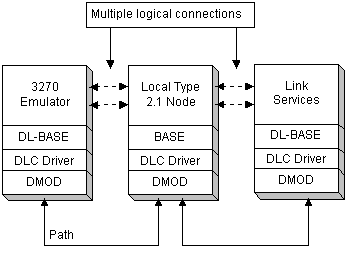
The local node provides the SNA layers of path control, transmission control, and data flow control (DFC), as well as logical unit (LU) services — see the following figure. In terms of the SNA layers, the FMI is between presentation services and DFC. This means that most of the SNA protocol handling is performed by the local node. In particular, the local node's DFC layer is responsible for the state changes associated with chaining, bracket, and quiesce protocols.
The FMI is defined in terms of the messages that are sent across the interface. Note that this is logically distinct from the definition of the DL-BASE/DMOD interface, which defines the mechanism for sending messages between two components in Microsoft® SNA Server (for example, between the local node and the 3270 emulator).
The FMI is used by LU types 0, 1, 2, and 3, but not by LU type 6.2. It provides access to the SSCP-LU session as well as the main PLU-SLU session ( see Sessions and Connections for more information on these sessions). An application can use the FMI to access multiple sessions, and hence multiple LUs, simultaneously.

In this example, the 3270 emulator on the client communicates over the LAN with the local node on the server machine by exchanging messages. The content and format of the messages are defined by the FMI. The DMOD component is used to transport the messages, but does not interpret them. The local node provides the SNA service for formatting the message. The link service and the data link control (DLC) driver are responsible for transferring data between the local node and the DLC adapter.